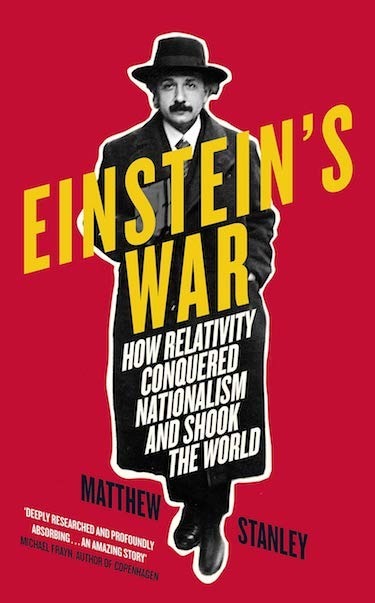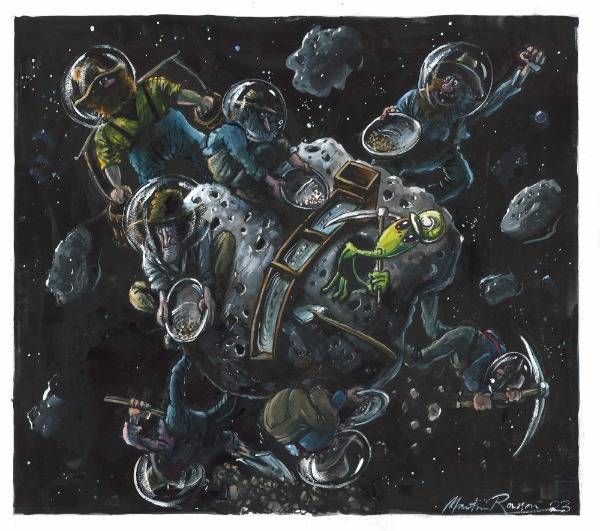
This article is a preview from the Winter 2019 edition of New Humanist
Einstein’s War: How Relativity Conquered Nationalism and Shook the World (Viking) by Matthew Stanley
During World War I, German infantry troops entered and destroyed the Belgian town of Louvain. The ancient university library there was entirely destroyed, along with irreplaceable treasures. The British prime minister Herbert Asquith described it as a “blind, barbarian act” and the Daily Mail plastered headlines across its pages about the “Holocaust of Louvain”. As Matthew Stanley puts it, “The town’s name quickly became shorthand for atrocities against culture and learning.”
The event also led to a Europe-wide view of Germans as being barbaric and uncivilised. In England there were calls for there to be no contact whatsoever with German academics or indeed, anyone German. In response, Ludwig Fulda, a Frankfurt playwright, drafted the so-called “Manifesto to the Civilised World”, which sought to defend German honour on the world stage. Ninety-three German intellectuals and scientists signed the manifesto, which denied all accusations of wrongdoing, asserting in fiery terms that it was not possible for Germans to commit crimes against art and science. Albert Einstein was one of the few scientists invited to sign it who refused. Einstein’s War is the story of the evolution of his general theory of relativity, which he formulated and perfected during the years of that grand conflagration.
During the war, Einstein spent most of his time based in Berlin. He was always keen to point out to anyone who wanted to know that, though born in Germany (Ulm), since 1894 he had held a Swiss passport, and he publicly and vociferously opposed the war. His personal circumstances made it difficult to complete and publicise his theory. He was assisted by many friends and colleagues. The general theory is often thought of as appearing fully formed, like Athena out of Zeus’s skull. That was not the case. It is well known that he wrote a letter to his then partner, Mileva – also a physicist – describing it as “our” theory. In addition to Mileva, he sought out assistance from a number of other scientists and mathematicians.
But even with their help, relativity remained enormously abstract for many scientists, who were sceptical of it. Many could not accept that light could have weight, a necessary concomitant of Einstein’s theory. Until proof of that was found, only a few scientists regarded the theory as having any real worth. Karl Schwarzschild, for example, noted that a strange feature of his solution to Einstein’s equations led to a “closed off” pocket of space-time forming. He concluded that this was a mathematical oddity of little significance. Later generations of physicists gave these “oddities” the name “black holes”.
Then entered the English astronomer and Quaker Arthur Eddington. His religious beliefs were important to this story, because with the war raging in Europe, he battled with the authorities to avoid being conscripted and to continue his scientific work in support of Einstein.
The fact that Einstein was based in Berlin, and regarded by many as German, only served to make Eddington and Einstein’s task more difficult. During the height of the war, a Breslau mathematician described the theory as an example of “German work” and used it to celebrate Kaiser Wilhelm II’s birthday, saying that the theory was only possible because of the German nation and its resources. Einstein was furious at this chauvinistic use of his work, publicly pointing out that he was a Jew, a Swiss citizen and “only a human without special favour toward any state or national entity”. Although they had never met up to that point, he and Eddington were clearly kindred spirits.
Eddington knew that in order to prove Einstein’s theory and that light had weight, it would have to be shown that it was susceptible to gravity. This could be done by demonstrating that light from a distant star is deflected by the sun. The experiment could only be done from Earth during a full eclipse. That is what Eddington and his colleagues did. Attempts had been made before, but politics and atmospheric conditions had prevented success – one group were arrested in the Crimea as spies. In 1919, Eddington’s team travelled to Principe, an island off the west coast of Africa, while another team, led by Charles Davidson, went to Sobral in Brazil to take photographs of the eclipse.
After painstaking analysis of the glass plates of photographs, Eddington was able to show that the actual position of stars in the Hyades was different from their apparent position, by a factor that perfectly reflected the predictions in Einstein’s theory. As a result of Eddington’s work, Einstein was acknowledged as a genius. The scientific community immediately knew that their world would never be the same again. Perhaps, just as importantly, the scientific world was forced to recognise that they could not ignore a theoretician simply because they were working in an enemy state.
The evolution of the general theory of relativity, from its early conception by a Swiss Jew working in Germany – the enemy of England and France – to its substantiation by an English Quaker, is a fascinating and gripping story and Stanley tells it with verve and erudition.

